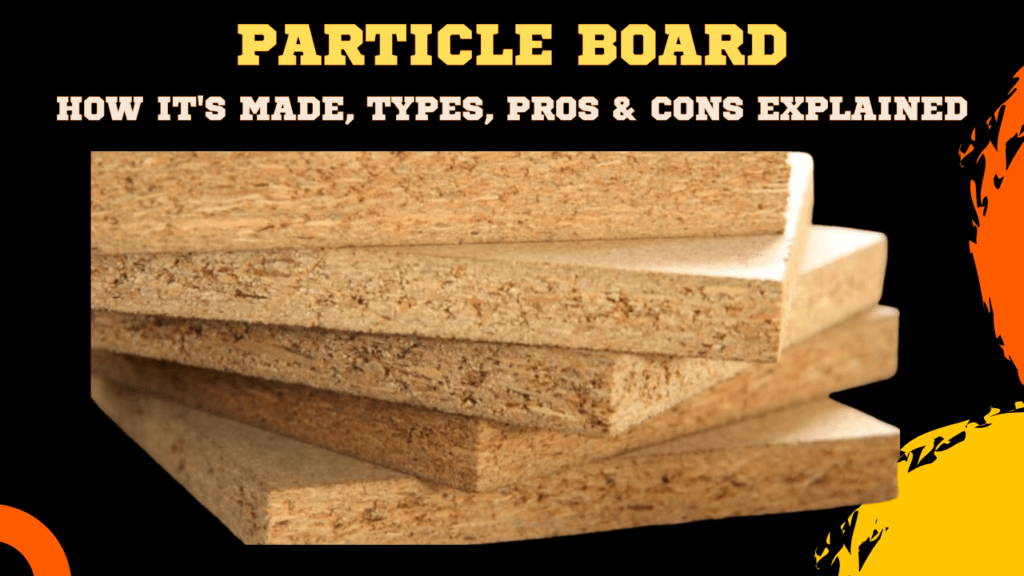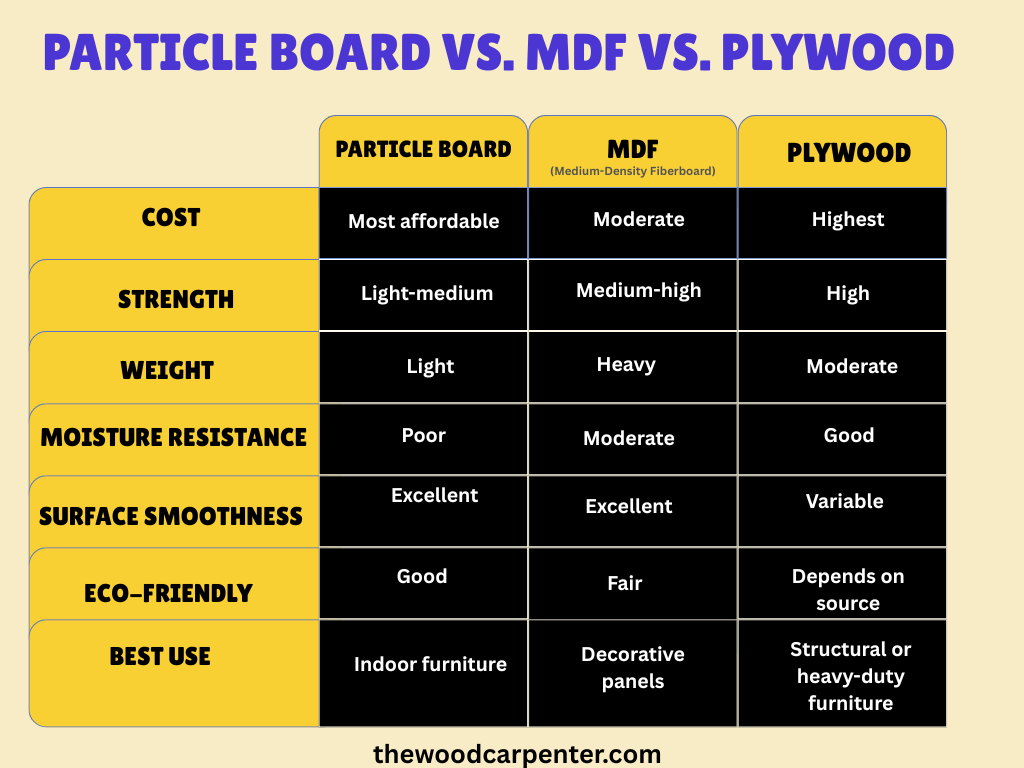
Particle Board: The Budget-Friendly Wood Alternative You Need to Know About
If you have ever browsed IKEA or an online furniture store, chances are that particle board furniture would have caught your eye – even if unknowingly. From minimalist desks and TV units to wardrobes and floating shelves – particle board has quietly become the backbone of modern interiors at an affordable price point.
But what exactly is particle board? And is it durable enough for use in projects like MDF or plywood? Thankfully, let’s provide some answers so that you can decide whether particle board fits into your next project or not. Let us break it all down for you and help you decide if particle board deserves its place!
What Is Particle Board, Really?
In simple terms, particle board (also called chipboard) it is a type of engineered wood. Instead of being cut directly from the trees, they are made by compressing the wood chips, sawdust, and shavings with a strong adhesive—usually a urea-formaldehyde resin—under high heat and pressure.
The result? Smooth, uniform boards that are easy to shape, cut, and finish.
How It’s Made (and Why That Matters)
The magic of particle board starts with the way it’s made:
- Wood Waste Collection: Sawdust, wood chips, and shavings are gathered from sawmills and furniture factories.
- Drying and Mixing: These materials are dried, cleaned, and mixed with adhesives and resins.
- Pressing and Heating: The blend is spread in layers, pressed into sheets at high temperature and pressure.
- Cooling and Finishing: Once cooled, the boards are trimmed, sanded, and possibly laminated.
Because it is machine-dried, each sheet comes out perfectly flat and uniform — no knots, splits or unexpected patterns in the grain as with solid wood. It’s that smooth surface that makes particle board a perfect partner for laminates, veneers and paints.
The Biggest Advantages of Particle Board
Despite what some may think, particle board isn’t just the “cheap option.” It actually has some serious perks when used smartly:
1. Affordable and Budget-Friendly
Let’s be honest—price matters. Particle board is among the most affordable materials there is. It’s constructed of recycled wood waste, which requires less raw timber and keeps cost of production low. So that’s why most flat-pack or RTA (ready-to-assemble) furniture uses it — it still keeps prices friendly without skimping on looks.
2. Lightweight and Easy to Handle
Moving a heavy oak cabinet is no small feat. Particle board furniture, on the other hand, is lightweight and easy to transport, making it a dream for apartments, offices, and DIY projects.
3. Smooth, Flawless Surface
Its surfaces are uniformly smooth (since it’s a factory product), so it is perfect for laminates, veneers or a fresh coat of paint. No sanding down bumps or dealing with uneven textures.
4. Eco-Friendly Option
One of the most underappreciated boons — it’s sustainable. Because it is manufactured with wood waste, it helps to limit deforestation and get full use of every piece of timber. Some contemporary editions also are assembled with low-formaldehyde adhesives for a healthier indoor air quality.
5. Sound and Thermal Insulation
High-density particle board variants can offer some sound and thermal insulation, contributing to lower noise levels and limited temperature changes, making them useful for office partitions or wall panels.
6. Low Maintenance
No regular polishing, no special oils— you can just wipe it clean, and you’re good to go.
The Downsides (and How to Work Around Them)
No material is perfect, and particle board has its weak spots. Knowing them helps you make smarter choices:
1. Moisture Sensitivity
Particle board hates water. It absorbs moisture quickly, leading to swelling or warping. That’s why it’s not ideal for bathrooms or outdoor use.
Tip: Use melamine-faced or laminated variants in humid areas for better protection.
2. Limited Weight Capacity
It isn’t designed to handle heavy loads. Bookshelves, yes. Granite countertops, not so much. If you need extra strength, go for thicker or high-density boards.
3. Shorter Lifespan
Furniture made from particle board usually lasts from 5 to 10 years. It’s not the forever material but great for renters or homeowners on a budget.
4. Possible Chemical Emissions
Lower-quality boards can release formaldehyde. Always look for E0 or CARB-compliant options to ensure safe indoor air quality.
5. Not Great for Reassembly
It’s not manufactured to take multiple screw insertions or even a carving — it will chip (or strip) in no time. Assemble it once, and leave it be.
Types of Particle Board (and Their Uses)
Manufacturers offer several varieties, each serving a unique purpose:
- Single-Layer Particle Board: Very basic and very cheap, this is for underlayment or short term furniture.
- Three-Layer Particle Board: It has better strength and stability than the two-layer particle board; can be used for furniture, cabinet and wall panel.
- Graded Density Board: Similar to the above, good in strength and finish; used for modular furniture.
- Melamine-Faced Particle Board (MFPB): Pre-laminated decorative surface—perfect for cabinets and desks.
- Veneered Particle Board: Covered in natural wood veneer for a more elegant, premium look.
- Cement-Bonded Particle Board: Cement add-on offers resistance to fire and moisture—ideal for construction or humid areas.
Common Uses
You’ll find particle board almost everywhere indoors:
- Furniture: Wardrobes, TV units, and desks.
- Cabinetry: Modular kitchen systems and office furniture.
- Wall Paneling: Smooth, modern interior walls.
- Flooring Underlay: Solid base for laminate flooring.
- False Ceilings: They are extremely light weight and it is very easy to work with, they can be installed in minutes.
Pro Tips to Make Particle Board Last Longer
Want your furniture to stay strong and stylish? Here’s how:
- Keep it dry—avoid the spills or damp walls
- Use edge banding to seal exposed sides.
- Do not exceed weight limits on shelves.
- Choose high-density or E0-grade boards for better durability.
- Don’t over-tighten screws—it can strip the material.
Particle Board vs. MDF vs. Plywood: Quick Comparison

Average Price of Particle Board Furniture
- U.S.: $20–$40 per 4×8 ft sheet (depending on finish and density).
How to Paint Particle Board (Step-by-Step)
- Give it a light sand to the surface to smooth it.
- Apply a primer designed for wood composites.
- Paint with either latex or oil-based paint in thin coats.
- To keep moisture from getting absorbed seal edges with wood sealer, or shellac.
- Let it dry completely before the use.
How to Repair Particle Board (Step-by-Step)
- Assess Damage: Identify cracks or swollen areas.
- Clean Surface: Remove debris or dust.
- Sand Edges: Sand damaged / rough surfaces for improved adhesion.
- Fill Gaps: Apply the wood filler or epoxy putty evenly.
- Dry Completely: Leave it for a few hours.
- Sand Smooth: Use fine-grit sandpaper.
- Seal Edges: Apply primer or sealer.
- Refinish Surface: Paint or laminate to match.
- Reinforce (Optional): For larger damage, glue wood strips on the back or replace panels if needed.
FAQs About Particle Board
1. Is particle board safe for indoor use?
Yes, if you choose low-emission (E0 or CARB-compliant) types that meet U.S. air quality standards.
2. Can I paint particle board?
Definitely. Just sand, prime, and paint for a smooth, lasting finish.
3. How long does it last?
Normally 5 -10 years if treated well and not getting wet often.
4. Can it get wet?
Not recommended. Opt for laminated ones in places that get damp.
5. Is it good for kitchen cabinets?
Yes — on upper cabinets, or in dry areas. Do not put base units near sinks unless waterproof.
6. How do I make it stronger?
Better to add laminates, seal the edges and not overload it.
Final Thoughts
Particle board isn’t fancy — but it’s smart. It is the ideal blend of low-cost, eco-friendly and functional. Good finish and care can make it just as chic as luxury materials — without burning a hole in your wallet. Whether you’re decking out a starter apartment, upgrading an office space, or rejuvenating your DIY home project game, particle board is proof that budget-friendly doesn’t mean low-quality.

